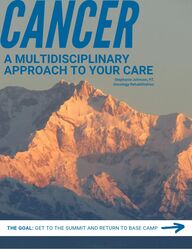
Return to flip book view
Message A MULTIDISCIPLINARYAPPROACH TO YOUR CARECANCERTHE GOAL: GET TO THE SUMMIT AND RETURN TO BASE CAMPStephanie Johnson, P.T.Oncology Rehabilitation
Stephanie Johnson, PT, MPT, is a Kansas native and a highly experiencedphysical therapist who has worked in a wide range of settings over her career.She holds certifications in functional applied science and oncologyrehabilitation and co-founded Maximum Physical Therapy and Fitness withher husband, Scott, in 2011. Meadowlark Cancer Program is a community health program provided byMeadowlark and a dedicated group of volunteers that offers freeprogramming open to adults of any age in the Flint Hills region affected bycancer.
ONCOLOGYTEAMSPOUSEFAMILYFRIENDSPHYSICALTHERAPISTLEGALCOUNSELOCCUPATIONALTHERAPISTCHIROPRACTORSPEECHPATHOLOGISTSPIRITUAL OR CULTURALADVISORYOGAINSTRUCTORFINANCIALADVISORMENTALHEALTHCOUNSELORDIETITIANWHY A TEAM APPROACHAlmost two million newcancer diagnoses per year inthe United States.It is estimated that there willbe more 26 million peopleliving with cancer by 2040.Cancer survivors are almostthree times more likely toreport fair or poor healthafter treatment.Cancer survivors are twiceas likely to havepsychosocial disabilities,and physical and functionallimitations.* Cancer survivors under theage of 65 are three timesless likely to return to work.* *Compared to those withoutcancer or with other chronicillness.the factsCancer treatmentsaves lives.Cancer and cancertreatment createadverse effects onyour body.People are living longer aftertreatment, and that’s changedwhat support looks like.What we’re learning from otherchronic illnesses is helping usrethink cancer care.We understand more now aboutwhat keeps our cells - and ourbodies - healthier, longer.Survivors are telling their storiesand asking for care that goesabove and beyond.PERSONALTRAINEREDUCATIONALRESOURCESAND
PHASE 0PRE-CANCER DIAGNOSIS:LET’S GET SERIOUS ABOUTQUALITY OF LIFE ANDLONGEVITY BEFORE NEEDING TOCLIMB THE MOUNTAIN.AssessGeneral Health, Mental Health, Activity, PhysicalFunction, Nutrition, & HydrationPreventCancer Screenings, Annual Physicals, & HealthAssessmentsPrepareBased on your assessments andprevention, are there areas you needto address? Identify who is going todevelop a plan that fits you.At 29,000 feet, climbers face extreme cold, dangerous winds, and 65%less oxygen. It takes 30 to 40 days to reach the summit and return to basecamp, but most spend 8 to 12 months in intense physical and mentaltraining just to prepare. Cancer treatment is no different. It demands planning, strength, andsupport, not just to get through the hardest part, but to come back downand recover fully. Like Everest, you can’t do it alone, and the climb isn’tover at the top.CLIMBING MOUNT EVEREST, LIKE GOING THROUGHCANCER TREATMENT, IS NOT JUST ABOUT REACHING THETOP, BUT BEING PREPARED FOR THE ENTIRE JOURNEY.
NUTRITIONHYDRATIONPHYSICALHEALTHFUNCTIONFINANCIALSTABILITYPHASE 1PREPARETIME OF DIAGNOSIS: YOU’REAT THE BASE OF THEMOUNTATIN, OVERWHELMEDBY THE CLIMB AHEAD ANDUNSURE WHERE TO BEGIN.Be organizedFind resourcesContinue yourhealthy habitsPrioritize your needsWhen prioritizing your needs, create a sense of control by consider the following ...What are my strengths and/or weaknesses?What am I going to need help with if things get hard?Who is on my team and do they undertand their role?ALWAYS ADDRESS YOUR BASIC NEEDS FIRST.MENTALHEALTHSLEEP
PHASE 2ACTIVE TREATMENT: THIS ISTHE STEEPEST PART OF THECLIMB. YOU’LL NEED TO PACEYOURSELF, LEAN ON YOUR TEAM,AND USE YOUR STRENGTHWHERE IT MATTERS MOST.Everyone’s journey is different. There’s no one-size-fits-all.Stick to the basics and take it one step at a time.Celebrate every win, no matter how small.The climb might get tougher, but keep going -you’re making progress.FINANCIALSTABILITYMaintain employment,prevent repeatedhospital expenses,identify access tofunding and availableresourcesNUTRITIONHYDRATIONEnsure you take inenough calories tofunction, combat fatigue,and prioritize hydrationfor fluid and electrolytebalanceMENTALHEALTHMaintain healthyrelationships withfamily, manageemotions, utilizehealthy strategies formanaging anxiety,depression, and fearPHYSICALHEALTHFUNCTIONFatigue management,pain management,mobility, cardiovascularfunction, manage weightloss, avoid significantfunctional limitations,falls, & injuriesSLEEPAim to get 6 to 8 hours of sleep, and strive toachieve 4 to 5 hours of deep sleep
PHASE 3MAINTENANCE OR TREATMENTCOMPLETION: YOU’VE REACHED THE SUMMIT, BUT GETTING BACK TOBASE CAMP TAKES TIME AND WORK.This stage is about recovery, not just relief. Finishing treatmentdoesn’t mean you’re “done”—your body and mind still need care,time, and attention. Here’s what to keep in mind:Don’t settle - this isn’t as good as it gets. Youdeserve more than just surviving. Recovery is abouttruly feeling well again.Things won’t go back to normal on their own.Healing takes work. Your energy, strength, andclarity will return, but they need support.Side effects don’t have to be permanent. If ignored,they can lead to bigger issues like long-termdisability, poor health, and even faster aging.Some challenges come from the treatment itself.These may include tissue or system injuries thattake time - sometimes months - to heal.Others are habits picked up during treatment. Likeresting more, eating differently, or moving less, andthey don’t always fall away when treatment ends.Your cells start healing quickly, but full recoverycan take time. Some damage begins to repair indays, but deeper healing can take up to ninemonths.Ways to CombatLingering Side EffectsActive RestAerobicConditioningBalance TrainingBone DensityTrainingCounselingDry NeedlingNutritionSupplementsJoint MobilizationLymphedemaTreatmentMeditationMindfulnessNutritionCounselingSleep TrainingSoft TissueTreatmentStrength TrainingYogaThe goal is to reach the summit—and return safely to base camp. That means preparing not just for treatment, but for the full journey. You’ll need educationand planning to know what’s ahead, a trusted team beside you—because no one climbs amountain alone—and a strong foundation of physical, mental, and nutritional training. Withthe right support and strategy, recovery isn’t just possible—it’s sustainable.
info@meadowlark.org / (785) 323-3878LEARN MORE